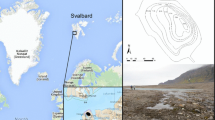Abstract
The biomass and production of lake charr, Salvelinus namaycush, was studied in Lake 223, a lake that was intentionally acidified to pH 5.0 and then allowed to gradually recover, and in Lake 224, a natural lake of neutral pH. During the first 6 years pH decreased, biomass of Lake 223 lake charr increased, primarily due to high recruitment during the initial years of acidification. Biomass then decreased the final year of acidification. Biomass of Lake 223 lake charr remained low during the subsequent 10 years of pH recovery and 5 additional years after lake pH had returned to neutral pH. Production of lake charr decreased during acidification and increased during pH recovery. Production was still at least an order of magnitude lower at the end of this study than 22 years earlier before lake pH was lowered. The continued low production was caused primarily by low abundance during the years of pH recovery and following years. Production per individual fish in Lake 223 decreased during acidification and quickly increased during pH recovery to values similar to that prior to acidification. Production, biomass, and production per individual varied little between years for lake charr in Lake 224.
Similar content being viewed by others
References cited
Beggs, G.L., J.M. Gunn & C.H. Olver. 1985. The sensitivity of Ontario lake trout (Salvelinus namaycush) and lake trout lakes to acidification. Ont. Fish. Tech. Rep. Ser. No. 17. 24 pp.
Chapman, D.W. 1978. Production in fish populations. pp. 5–25. In: S.D. Gerking (ed.) Ecology of Freshwater Fish Production, Blackwell Scientific Publications, Oxford.
Cleugh, T.R. & B.W. Hauser. 1971. Results of the initial survey of the Experimental Lakes Area, northwestern Ontario. J. Fish. Res. Board Can. 28: 129–137.
Cruikshank, D.R. 1984. Whole lake chemical additions in the Experimental Lakes Area. 1969- 1983. Can. Data Rep. Fish. Aquat. Sci. 449. 23 pp.
Downing, J.A. & C. Plante. 1993. Production of fish populations in lakes. Can. J. Fish. Aquat. Sci. 50: 110–120.
Ferreri, C.P. & W.W. Taylor. 1996. Compensation in individual growth rates and its influence on lake trout population dynamics in Michiganwaters of Lake Superior. J. Fish. Biol. 49: 763–777.
Gunn, J.M. 1989. Survival of lake charr (Salvelinus namaycush) embryos under pulse exposure to acidic runoff chemistry. pp. 23–45. In: J.A. Nriagu (ed.) Aquatic Toxicology and Water Quality Management, Wiley & Sons, New York.
Gunn, J.M. & W. Keller. 1990. Biological recovery of an acid lake after reductions in industrial emission of sulfur. Nature 345: 431–433.
Gunn, J.M. & K.H. Mills. 1998. The potential for restoration of acid-damaged lake trout lakes. Restoration Ecol. 6: 390–397.
Haw, F., P.K. Bergman, R.D. Fralick, R.M. Buckley & H.L. Blankenship. 1990. Visible implanted fish tag. Amer. Fish. Soc. Symp. 7: 311–315.
Healey, M.P. 1978. The dynamics of exploited lake trout populations and implications for management. J. Wildl. Manage. 42: 307–328.
Hedin, L.O., L. Granat, G.E. Likens, T.A. Buishand, J.N. Galloway, T.J. Butler & H. Rodhe. 1994. Steep declines in atmospheric cations in regions of Europe and North America. Nature 367: 351–354.
Jeffries, D.S., T.A. Clair, P.J. Dillon, M. Papineau & M.P. Stainton. 1995. Trends in surface water acidification at ecological monitoring sites in southeastern Canada (1981- 1993). Water, Air and Soil Pollution 85: 577–582.
Jolly, G.M. 1965. Explicit estimates from capture-recapture data with both death and immigration - stochastic model. Biometrika 52: 225–247.
Mills, K.H. 1985. Response of lake whitefish (Coregonus clupeaformis) to fertilization of Lake 226, the Experimental Lakes Area. Can. J. Fish. Aquat. Sci. 42: 129–138.
Mills, K.H. & R.J. Beamish. 1980. Comparison of fin-ray and scale age determinations for lake whitefish (Coregonus clupeaformis) and their implications for estimates of growth and annual survival. Can. J. Fish. Aquat. Sci. 37: 534–544.
Mills, K.H. & S.M. Chalanchuk. 1987. Population dynamics of lake whitefish (Coregonus clupeaformis) during and after the fertilization of Lake 226, the Experimental Lakes Area. Can. J. Fish. Aquat. Sci. 44(Suppl. 1): 55–63.
Mills, K.H., S.M. Chalanchuk, L.C. Mohr & I.J. Davies. 1987. Responses of fish populations in Lake 223 to 8 years of experimental acidification. Can. J. Fish. Aquat. Sci. 44(Suppl. 1): 114–125.
Mills, K.H., S.M. Chalanchuk & D.J. Allan. 2000. Recovery of fish populations in Lake 223 from experimental acidification. Can. J. Fish. Aquat. Sci. 57: 192–204.
Mills, K.H., S.M. Chalanchuk & D.J. Allan. 2002. Abundance, annual survival, and recruitment of unexploited and exploited lake charr, Salvelinus namaycush, populations at the Experimental Lakes Area, northwestern Ontario. Env. Biol. Fish. (this volume).
Ricker, W.E. 1975. Computation and interpretation of biological statistics of fish populations. Bull. Fish. Res. Board Can. 191. 382 pp.
Schindler, D.W., K.H. Mills, D.F. Malley, D.L. Findlay, J.A. Shearer, I.J. Davies, M.A. Turner, G.A. Linsey & D.R. Cruikshank. 1985. Long-term ecosystem stress: the effects of experimental acidification on a small lake. Science 228: 1395–1401.
Seber, G.A.F. 1982. The estimation of animal abundance and related parameters, 2nd ed. Macmillan Publishing, New York. 654 pp.
Shearer, J.A., E.J. Fee, E.R. DeBruyn & D.R. DeClercq. 1987. Phytoplankton primary production and light attenuation responses to the experimental acidification of a small Canadian Shield lake. Can. J. Fish. Aquat. Sci. 44(Suppl. 1): 83–90.
Walters, C.J., G. Steer & G. Spangler. 1980. Responses of lake trout (Salvelinus namaycush) to harvesting, stocking, and lamprey reduction. Can. J. Fish Aquat. Sci. 37: 2133–2145.
Welch, H.E. & K.H. Mills. 1981. Marking fish by scarring soft fin rays. Can. J. Fish. Aquat. Sci. 38: 1168–1170.
White, W.J. & R.J. Beamish. 1972. A simple fish tag suitable for long-term marking experiments. J. Fish. Res. Board Can. 29: 339–341.
Yan, N.D., W. Keller, N.M. Scully, D.R.S. Lean & P.J. Dillon. 1996. Increased UV-B penetration in a lake owing to droughtinduced acidification. Nature 381: 141–143.
Author information
Authors and Affiliations
Rights and permissions
About this article
Cite this article
Mills, K.H., Chalanchuk, S.M. & Allan, D.J. Biomass and Production of Lake Charr During the Acidification and PH Recovery of A Small Ontario Lake. Environmental Biology of Fishes 64, 293–301 (2002). https://doi.org/10.1023/A:1016075001977
Issue Date:
DOI: https://doi.org/10.1023/A:1016075001977




